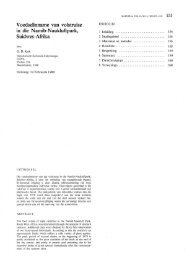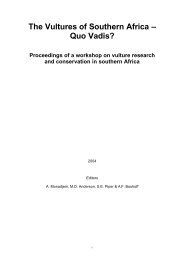Demarcation of Water Basins on National Level - EIS
Demarcation of Water Basins on National Level - EIS
Demarcation of Water Basins on National Level - EIS
You also want an ePaper? Increase the reach of your titles
YUMPU automatically turns print PDFs into web optimized ePapers that Google loves.
Basin <str<strong>on</strong>g>Demarcati<strong>on</strong></str<strong>on</strong>g><br />
The proposed basin is relatively large and includes important commercial farming areas but also<br />
tourism and envir<strong>on</strong>mental sensitive areas. For practical and management purposes the basin shall be<br />
divided into at least two sub-basins, i.e. the Upper Ugab Sub-Basin (Otavi, Otjiwar<strong>on</strong>go, Outjo) and<br />
the Lower Ugab-Huab Sub-Basin (Khorixas, Kamanjab, Cape Cross).<br />
2.8 TSONDAB-KOICHAB BASIN<br />
2.8.1. Physiographic Parameters<br />
The Ts<strong>on</strong>dab-Koichab Basin is framed by the Kuiseb Basin in the north, the Orange-Fish Basin in the<br />
east and south and by the Atlantic Ocean in the west. The surface and groundwater drainage is directed<br />
towards the Atlantic in the west. The eastern boundary <str<strong>on</strong>g>of</str<strong>on</strong>g> the basin follows mainly the surface water<br />
divide, in the north roughly the water divide between the Kuiseb and Ts<strong>on</strong>dab rivers.<br />
All rivers south <str<strong>on</strong>g>of</str<strong>on</strong>g> the Kuiseb River do not reach the Atlantic Ocean in a well-defined riverbed.<br />
However, there are indicati<strong>on</strong>s that they c<strong>on</strong>tinue under the Namib Dune Sea and eventually discharge<br />
into the ocean. The catchments <str<strong>on</strong>g>of</str<strong>on</strong>g> these rivers are not well defined and it is necessary to combine them<br />
into <strong>on</strong>e basin.<br />
The desert landscape and envir<strong>on</strong>ment <str<strong>on</strong>g>of</str<strong>on</strong>g> the basin is similar throughout the proposed basin between<br />
the Ts<strong>on</strong>dab River in the north and the former Sperrgebiet area in the south and can be described as<br />
<strong>on</strong>e envir<strong>on</strong>mental unit.<br />
2.8.2. Populati<strong>on</strong> Density and Political/Administrative Areas<br />
The basin is sparsely populated with the vast majority <str<strong>on</strong>g>of</str<strong>on</strong>g> people living at Lüderitz, and the separati<strong>on</strong><br />
<str<strong>on</strong>g>of</str<strong>on</strong>g> the basin into smaller units would not be advisable for management and financial reas<strong>on</strong>s.<br />
Most <str<strong>on</strong>g>of</str<strong>on</strong>g> the proposed basin area is demarcated as nati<strong>on</strong>al park and private c<strong>on</strong>servancy, mainly to<br />
protect the unique Namib Desert envir<strong>on</strong>ment. In the north the borderline follows the regi<strong>on</strong>al<br />
boundary between Hardap and Er<strong>on</strong>go. The mining town Oranjemund in the south is excluded as<br />
being part <str<strong>on</strong>g>of</str<strong>on</strong>g> the proposed Orange-Fish Basin.<br />
2.9 ORANGE-FISH BASIN<br />
2.9.1. Physiographic Parameters<br />
The Orange-Fish Basin is located in the south-central part <str<strong>on</strong>g>of</str<strong>on</strong>g> Namibia and is defined mainly by the<br />
surface catchments <str<strong>on</strong>g>of</str<strong>on</strong>g> the Orange and Fish rivers. The Fish River originates in the Nama Plains<br />
northwest <str<strong>on</strong>g>of</str<strong>on</strong>g> Maltahöhe, and flows in a southern directi<strong>on</strong> towards the perennial Orange River. The<br />
c<strong>on</strong>fluence <str<strong>on</strong>g>of</str<strong>on</strong>g> both rivers is some 35 km southwest <str<strong>on</strong>g>of</str<strong>on</strong>g> Ai Ais within the Fish River Cany<strong>on</strong> Park.<br />
The Orange River originates in South Africa and defines the border between Namibia and South<br />
Africa between Ariamsvlei in the east and Oranjemund at the Atlantic Ocean. The basin comprises all<br />
tributaries towards the Fish and Orange rivers within the c<strong>on</strong>fines <str<strong>on</strong>g>of</str<strong>on</strong>g> Namibia.<br />
In some areas, mostly al<strong>on</strong>g the western basin margin, the boundary deviates slightly from the surface<br />
water catchment, where groundwater basins and geological formati<strong>on</strong>s are c<strong>on</strong>sidered as more critical<br />
criteria for the definiti<strong>on</strong> <str<strong>on</strong>g>of</str<strong>on</strong>g> the basin.<br />
Bittner <str<strong>on</strong>g>Water</str<strong>on</strong>g> C<strong>on</strong>sult 2004 GTZ, MAWRD<br />
10




